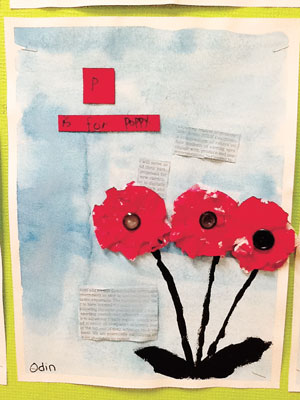This is the time when we, as Canadians, take time to remember the countless sacrifices made by forebearerss in the service of Canada and freedom.
From a young age, every Canadian learns about the importance of November 11. The Mail spoke with Drumheller’s Schools to learn what students are taught throughout their education.
At the elementary level, the curriculum may not officially address Remembrance Day, but teachers make sure to take the time and do something special.

Students in Shauna Johnson’s art class, (clockwise from left) Cair Boyko, Molly McNeil, Samantha Kendell, Mackenzie Halase, Brandon Holden, and Cameron Trodd, work on some Remembrance Day artwork. Throughout their eduction, students learn the importance of Remembrance Day and the sacrifices made for freedom.
“For this age, there’s not a lot in the curriculum, but each teacher does something, like an art project, poem, or information from the Legion or Veteran Affairs, and we use that to teach the children about Remembrance Day. We draw on different things, and depending the age, that’s how we teach it to them. As we get into the older grades we do a bit more,” said Greentree School principal Chris Connell.
Many Canadians have a personal connection to Remembrance Day, and Connell uses his to help teach.
“I go around to the classrooms and talk about World War 1, because my great grandfather was in it. I talk about what he and the soldiers went through, how it started, and Canada’s role,” said Connell.
“They’re really fascinated, because for a lot of the kids, these events were so long ago it’s really brand new. They get quite interested.”
The curriculum in Alberta most directly addresses the themes of Remembrance Day at the high school level, where students learn about the major events and ideologies of the modern era.
“Given the subject matter throughout Social Studies, senior high students learn about globalization in Grade 10, nationalism in Grade 11, and ideology in Grade 12. They learn about the causes of war, what happened in the back rooms, how people felt, and the ideologies that take root,” said Peter Bjel, Social Studies teacher with Drumheller Valley Secondary School.
“Indirectly, we think about Canada’s role in wars and addressing other ideologies that were threatening in the past, which meshes into Remembrance Day.”
Overall the themes of Canada’s role and sacrifices are mentioned throughout the high school Social Studies curriculum.
“The Social Studies 10 curriculum is very much tied to contemporary war. It focuses on peacekeeping and the efforts to prevent wars by the United Nations. It also talks about the sacrifices made by Canadians during the peacekeeping efforts,” said Kurt Phillips, a humanities teacher with St. Anthony’s School “We talk about the first World War and the second, what led to them, and the legacy of these events.”
In addition the curriculum also addresses Canada’s peacekeeping efforts and some of Canada’s dark chapters during these times.
“One thing Alberta Social Studies really pays attention to is peacekeeping and the roles of groups that were marginalized in the past, like Aboriginal and Francophone Canadians. They’re remembered and commemorated in the process, too,” said Bjel.
However, the most powerful tool to engage students is to make Remembrance Day personal.
“A lot of students tell their own stories as well. It makes the history more alive and more touching. Whenever we teach about history, even if some students are particularly interested, Remembrance Day is always something that interests them,” said Phillips.
On Monday, November 11, the nation commemorates Remembrance Day. However, Drumheller’s schools will be holding their Remembrance Day ceremonies starting tomorrow. On Thursday, November 7, Drumheller Valley Secondary School and Greentree School are holding their ceremonies, while St. Anthony’s School hold theirs on Friday.


















